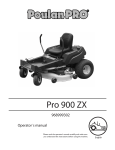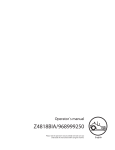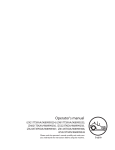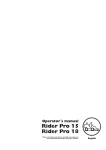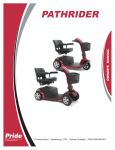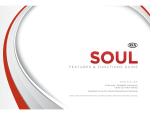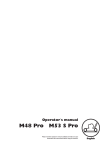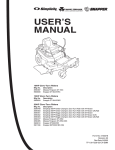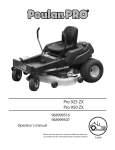Download Husqvarna WH4817EFQ2 User's Manual
Transcript
Operator´s manual WH4817EFQ/968999252 WH5219EFQ/968999253 Please read the operator’s manual carefully and make sure you understand the instructions before using the machine. English OPERATOR’S MANUAL MOWER WH4817EFQ WH5219EFQ Contents Contents.................................................................. 1 Introduction ............................................................ 3 Congratulations................................................... 3 General ............................................................... 3 Driving and Transport on Public Roads .............. 3 Towing ................................................................ 3 Operating ............................................................ 3 Good Service ...................................................... 4 Manufacturing Number ....................................... 4 Symbols and Decals .............................................. 5 Safety Instructions................................................. 7 General Use........................................................ 7 Driving on Slopes................................................ 9 Children............................................................. 10 Maintenance ..................................................... 11 Transport........................................................... 14 Customer responsibilities.................................. 14 Controls ................................................................ 15 Control Locations .............................................. 15 1. Ground Speed Lever..................................... 16 2. Choke Control ............................................... 16 3. Ignition Switch............................................... 16 4. Operator Presence Lever.............................. 17 5. Throttle Control ............................................. 17 6. Blade Engagement Switch............................ 18 7. Neutral Bail ................................................... 18 8. Hour Meter .................................................... 19 9. Motion control levers..................................... 19 10. Tracking Knob............................................. 20 11. Refueling..................................................... 20 12. Fuel Shut-off Valve ..................................... 21 Fuses ................................................................ 21 Lifting Lever for the Mower Deck ...................... 22 Pump release valves......................................... 22 Accessories....................................................... 23 Operation .............................................................. 24 Training ............................................................. 24 To move forward and backward........................ 24 Before Starting .................................................. 25 Starting the Engine ........................................... 25 To start an engine with a weak battery ............. 28 Running............................................................. 29 Reversing.......................................................... 29 To operate on hills ............................................ 30 Mowing Tips ..................................................... 30 Stopping............................................................ 32 Stopping the Engine......................................... Adjustment of cutting height............................. Wheel Motor Adjustment.................................. Moving Machine by Hand................................. Maintenance ........................................................ Maintenance Schedule..................................... Battery.............................................................. Ignition System................................................. Checking the Safety System ............................ Checking the Engine's Cooling Air Intake ........ Checking and Adjusting the Choke Cable........ Replacing the Air Filter..................................... Replacing the Fuel Filter .................................. Checking the Fuel Pump’s Air Filter................. Checking Tire Pressures.................................. Checking the V-belts ........................................ Checking the Blades ........................................ Adjusting the Mower Deck ............................... Cleaning and Washing ..................................... Caster Wheels.................................................. Hardware.......................................................... Blade replacement ........................................... Lubrication........................................................... Lubrication Schedule........................................ General ............................................................ Lubricating the Cables ..................................... Lubricating in Accordance with the Lubrication Schedule .......................................................... Trouble Shooting Guide ..................................... Storage ................................................................. Winter Storage ................................................. Service ............................................................. Wiring diagrams .................................................. Technical Data .................................................... Torque Specifications....................................... Conformity Certificates....................................... USA requirements............................................ Service Journal ................................................... Delivery Service ............................................... After the First 8 Hours ...................................... 25-Hour Service ............................................... 50-Hour Service ............................................... 100-Hour Service ............................................. 300-Hour Service ............................................. At Least Once Each Year................................. 33 34 34 34 35 35 37 38 39 40 40 41 42 42 42 43 44 45 47 47 47 48 49 49 49 50 50 55 58 58 58 59 61 62 63 63 64 64 64 65 66 67 68 69 English-1 WARNING! Failure to follow cautious operating practices can result in serious injury to the operator or other persons. The owner must understand these instructions, and must allow only trained persons who understand these instructions to operate the mower. Each person operating the mower must be of sound mind and body and must not be under the influence of any mind altering substance. WARNING! Engine exhaust, some of its constituents, and certain vehicle componets contain or emit chemicals known to the State of California to cause cancer and birth defects or other reproductive harm. WARNING! Battery posts, terminals and related accessories contain lead and lead compounds, chemicals known to the State of California to cause cancer and birth defects or other reproductive harm. Wash hands after handling. English-2 INTRODUCTION Introduction Congratulations Thank you for purchasing a Husqvarna Walk-Behind Mower. This machine is built for the greatest efficiency and rapid mowing primarily of large areas. Controls in one place and a transmission regulated by steering controls contribute to the machine’s performance. This manual is a valuable document. Following the instructions (use, service, maintenance, etc.) can considerably increase the lifespan of your machine and even increase its resale value. If you sell your machine, be sure to give this Operator’s Manual to the new owner. The final chapter of this Operator’s Manual comprises a Service Journal. Ensure that service and repair work is documented. A well kept service journal reduces service costs for the season-based maintenance and affects the machine’s resale value. Take the Operator’s Manual along when the machine is left to the workshop for service. General In this Operator’s manual, left and right, backward and forward are used in relation to the machine’s normal driving direction. Driving and Transport on Public Roads Check applicable road traffic regulations before driving and transport on public roads. If the machine is transported, you should always use approved fastening equipment and ensure that the machine is well anchored. Towing Do not tow this machine, it may cause damage to the drive system. Do not tow any trailers, etc. with this mower. They may jackknife or overturn causing damage to the mower and possibly serious injury to the operator. Operating This machine is constructed only for mowing grass on lawns and other free and level ground without obstacles such as stones, tree stubs, etc. The machine can also be used for other tasks when equipped with special accessories provided by the manufacturer, for which the operating instructions are provided in conjunction with delivery. All other types of use are incorrect. The manufacturer’s directions concerning operation, maintenance, and repairs must be carefully followed. Lawnmowers and all power equipment, can be potentially dangerous if used improperly. Safety requires good judgement, careful use in accordance with these instructions and common sense. The machine must only be operated, maintained, and repaired by persons that are familiar with the machine’s special characteristics and who are well versed in the safety instructions. Accident prevention regulations, other general safety regulations, occupational safety rules, and traffic regulations must be followed without fail. Unauthorized modifications to the design of the machine may absolve the manufacturer from liability for any resulting personal injury or property damage. English-3 INTRODUCTION Good Service Husqvarna’s products are sold all over the world and only in specialized retail stores with complete service. This ensures that you as a customer receive only the best support and service. Before the product is delivered, the machine has, for example, been inspected and adjusted by your retailer, see the certificate in the Service Journal in this Operator’s Manual. When you need spare parts or support in service questions, warranty issues, etc., please consult the following professional: This Operator’s Manual belongs to the machine with manufacturing number: Engine Transmission Manufacturing Number The machine’s manufacturing number can be found on the printed plate of the rear part of the chassi. Stated on the plate, from the top are: • The machine’s type designation (I.D.). • The manufacturer's type number (Model). • The machine’s serial number (Serial no.) Please state the type designation and serial number when ordering spare parts. The engine’s manufacturing number is stated on a barcode decal. This is placed on the left side of the crankcase, in front of the start motor. The plate states: • The engine’s serial number (E/NO). • The engine’s type designation (Code). Please state these when ordering spare parts. The hydraulic pump’s manufacturing number is stated on a barcode decal affixed to the left side of the pump housing. The plate states: • The pump’s type designation. • The pump’s serial number. The hydraulic motor’s manufacturing number is stated on a round metal plate. This is placed on the gable inside the motor. The plate states: • The hydraulic motor’s type designation and design version. • The hydraulic motor’s serial number. English-4 SYMBOLS AND DECALS Symbols and Decals These symbols are found on the machine and in the operator’s manual. Study them carefully so that you know what they mean. WARNING! Xxxxxxx xxxx xxxxxxxx xxx x Xxxxx xxxxxx xx. xx xxxxxxxx xxxxx xxx xx. Used in this publication to notify the reader of a risk of personal injury, particularly if the reader should neglect to follow instructions given in the manual. IMPORTANT INFORMATION Xxxxxxx xxxx xxxxxxxx xxx xxx xxxx xxxxxx xx. Used in this publication to notify the reader of a risk of material damage, particularly if the reader should neglect to follow instructions given in the manual. Used also when there is a potential for misuse or misassembly. Warning! Noise emissions to the surroundings in accordance with the European Union’s directive. The machine’s emission is stated in the chapter TECHNICAL DATA and on the decals. CE conformity marking Only machines for European market Battery acid is corrosive, explosive, and flammable Slow Fast Choke Warning! Rotating blades, keep away from the discharge deck Use protective glasses Use protective gloves Fuel Do not touch rotating parts Do not stand here English-5 SYMBOLS AND DECALS Moving sharp blades under cover English-6 Keep a safe distance from the machine. Severing of fingers & toes. Read Operator´s Manual. Rotating blades Whole body exposure to thrown objects. Shut off engine & remove key before performing any maintenance or repair work. SAFETY INSTRUCTIONS Safety Instructions These instructions are for your safety. Read them carefully. WARNING! This symbol means that important safety instructions need to be emphasized. It concerns your safety. General Use • Read all instructions in this operator’s manual and on the machine before starting it. Ensure that you understand them and then abide by them. • Learn how to use the machine and its controls safely and learn how to stop quickly. Also learn to recognize the safety decals. • Only allow the machine to be used by adults who are familiar with its use. • Make sure nobody else is in the vicinity of the machine when you start the engine, engage the drive, or run the machine. • Make sure animals and people maintain a safe distance from the machine. • Stop the machine if someone enters the work area. • Clear the area of objects such as stones, toys, steel wire, etc. that may become caught in the blades and thrown out before operating the unit. • Beware of the discharge deck and do not point it at any one. Do not use the machine without the discharge chute in place. • Stop the engine and prevent it from starting before you clean the deck. • Remember that the operator is responsible for dangers or accidents. • Never take passengers. The machine is only intended for use by one person. • Always look down and behind before and during reversing maneuvers. Look out for both large and small obstacles. • Slow down before turning. 8011-630 Read the operator’s manual before starting the machine 8011-631 Clear the area of objects before mowing 8011-632 Never take passengers English-7 SAFETY INSTRUCTIONS • Shut down the blades when not mowing. • Be careful when turning around fixed objects, so that the blades do not hit them. Never drive over foreign objects. • Only use the machine in daylight or in other well-lit conditions. Keep the machine a safe distance from holes or other irregularities. Pay attention to other possible risks. • Never use the machine if you are tired, if you have consumed alcohol, or if you are taking other drugs or medication that can affect your vision, judgment, or coordination. • Beware of traffic when working near or crossing a road. • Never leave the machine unsupervised with the engine running. Always shut down the blades, engage the parking brake if so equipped, stop the engine, and remove the ignition key before leaving the machine. • Never allow children or other persons not trained in the use of the machine to use or service it. Local laws may regulate the age of the user. WARNING! Engine exhaust and certain vehicle components contain or emit chemicals considered to cause cancer, birth defects, or other reproductive system damage. The engine exhaust contains carbon monoxide, which is a colorless, poisonous gas. Do not use the machine in enclosed spaces. 8011-633 Keep children away from the work area WARNING! When using the machine, approved personal protective equipment should be used. Personal protective equipment cannot eliminate the risk of injury but it will reduce the degree of injury if an accident does happen. Ask your retailer for help in choosing the right equipment. • Make sure that you have first aid equipment close at hand when using the machine. • Never use the machine when barefoot. Always wear protective shoes or boots, preferably with steel toecaps. • Always wear approved protective glasses or a full visor when assembling or driving. • Always wear gloves when handling the blades. • Never wear loose clothing that can get caught in moving parts. • Use ear protectors to avoid impaired hearing. 8011-670 English-8 Personal protective equipment SAFETY INSTRUCTIONS Driving on Slopes Driving on slopes is one of the operations where the risk is greatest that the driver will lose control or the machine will tip over, which can result in serious injury or death. All slopes require extra caution. If you cannot reverse up a slope or if you feel unsure, do not mow the slope. Do as follows • Remove obstacles such as stones, tree branches, etc. • Watch out for and avoid driving over furrows, holes, and bumps. On uneven terrain, the machine can tip more easily. Long grass can hide obstacles. • Mow up and down, not side-to-side. • If machine stops while going uphill, disengage blades and back down slowly. • Drive evenly and slowly. Use small movements of the motion control levers. • Be extra cautious with any additional equipment, which can alter the machine’s stability. 8011-634 Mow up and down, not side-to-side Do not • Do not make sudden changes in speed or direction. • Do not drive the machine on terrain that slopes more than 10°. • Do not mow near verges, ditches, or banks. The machine can suddenly spin around if a wheel goes over the edge of a drop or ditch, or if an edge gives way. • Do not mow wet grass. It is slippery, and the tires can lose their grip, so that the machine slides. • Avoid unnecessary turns on slopes, and if it proves necessary, turn slowly and gradually downward, if possible. • 8011-635 Be extra cautious when driving on slopes Avoid starting or stopping on a slope. If the tires begin to slip, shut off the blades and drive slowly straight down the slope. English-9 SAFETY INSTRUCTIONS Children • Serious accidents may occur if you fail to be on guard for children in the vicinity of the machine. Children are often attracted to the machine and mowing work. Never assume that children will stay where you last saw them. • Keep children away from the mowing area and under close supervision by another adult. • Keep an eye out and shut off the machine if children enter the work area. • Before and during a reversing maneuver, look backward and downward for small children. • Never allow a child to ride with you. They can fall off and injure themselves seriously or prevent risk-free maneuvering of the machine. • Never allow children to operate the machine. • Be particularly cautious near corners, bushes, trees, or other objects that block your view. 8011-636 English-10 Never allow children to operate the machine SAFETY INSTRUCTIONS Maintenance WARNING! The engine must not be started when the protective plate for the mower deck’s drive belt is removed. • Stop the engine. Prevent the engine from starting by removing the spark plug cables from the spark plugs or by removing the ignition key before making any adjustments or performing maintenance. • Never fill the fuel tank indoors. • Fuel and fuel fumes are poisonous and extremely flammable. Be especially cautious when handling fuel, as carelessness can result in personal injury or fire. • Only store fuel in containers approved for the purpose. • Never remove the fuel tank cap and never fill the fuel tank while the engine is running. • Allow the engine to cool before refueling. Do not smoke. Do not fill fuel in the vicinity of sparks or open flames. • If leaks arise in the fuel system, the engine must not be started until the problem has been resolved. • Store the machine and fuel in such a way that there is no risk of leaking fuel or fuel vapor leading to damages. • Check the fuel level before each use and leave space for the fuel to expand, because the heat from the engine and the sun may otherwise cause the fuel to expand and overflow. • Avoid overfilling. If you spill fuel on the machine, wipe up the spill and wait until it has evaporated before starting the engine. If you have spilled fuel on your clothing, change your clothing. • Allow the machine to cool before taking any actions in the engine compartment. • Be very careful when handling battery acid. Acid on skin can cause serious corrosive burns. If you spill battery acid on your skin, rinse immediately with water. 8011-637 Never fill the fuel tank indoors WARNING! The engine, the exhaust system, and the hydraulic system’s components become very warm during operation. Risk for burns if touched. Use protective glasses when handling the battery. WARNING! The battery contains lead and lead compounds, chemicals that are considered to cause cancer, birth defects, and other reproductive system damage. Wash your hands after touching the battery. English-11 SAFETY INSTRUCTIONS • Acid in the eyes can cause blindness, contact a doctor immediately. • Be careful when servicing the battery. Explosive gases form in the battery. Never perform maintenance on the battery when smoking or near open flames or sparks. The battery can explode and cause serious injury/ damage. • Ensure that nuts and bolts, especially the fastening bolts for the blade attachments, are properly tightened and that the equipment is in good condition. • Do not modify safety equipment. Check regularly to be sure it works properly. The machine must not be driven with defective or unmounted protective plates, protective cowlings, safety switches, or other protective devices. • Do not change the settings of governors and avoid running the engine with overly high engine speeds. If you run the engine too fast, you risk damaging the machine components. • Sparking can occur when working with the battery and the heavy cables of the starter circuit. This can cause battery explosion, fire or eye injury. Sparking in this circuit can not occur after that the chassis cable (normally negative, black) is removed from the battery. 6003-009 Do not smoke when performing maintenance on the battery. The battery can explode and cause serious injury/damage 8009-728 WARNING! Risk of sparking Avoid sparking and its consequences by the following routines: Use protective goggles. Ensure that the fuel filler cap is mounted and no flammable substances is stored in an open container. Never working with the starter circuit if there is spilled fuel. Disconnect the negative cable from the battery first and connect it last. DO NOT short circuit the starter relay in order to run the starter. • Never use the machine indoors or in spaces lacking proper ventilation. The exhaust fumes contain carbon monoxide, an odorless, poisonous, and lethal gas. English-12 8011-638 Never drive the machine in an enclosed space SAFETY INSTRUCTIONS • Stop and inspect the equipment if you run over or into anything. If necessary, make repairs before starting. • Never make adjustments with the engine running. • The machine is tested and approved only with the equipment originally provided or recommended by the manufacturer. • The blades are sharp and can cause cuts and gashes. Wrap the blades or use protective gloves when handling them. • When mowing familiar areas use the mulch deck. • Reduce the risk of fire by removing grass, leaves, and other debris that may have accumulated on the machine. Allow the machine to cool before putting it in storage. • Have your mower inspected and serviced each year by an authorized Husqvarna dealer. • Use only authentic Husqvarna replacement parts to insure that the safety and quality of your mower is maintained. • Safety decals should be replaced if they are missing or illegible. Decals can be purchased from your Husqvarna dealer. • Use protective glasses at maintenance work. 8011-639 Clean the machine regularly The hydraulic system including all hoses and fittings should be checked frequently for wear or leaks. Never check for leaks with your hands, use a piece of cardboard or wood. Hydraulic oil under pressure could be injected into your body and must be surgically removed within a few hours. English- 13 SAFETY INSTRUCTIONS Transport • The machine is heavy and can cause serious crushing injuries. Be extra cautious when it is loaded on or unloaded from a vehicle or trailer. • Use an approved trailer to transport the machine. Activate the parking brake, turn off the fuel supply, and fasten the machine with approved fastening devices, such as bands, chains, or ropes, when transporting. • Check and abide by local traffic regulations before transporting or driving the machine on any road. • Do not tow this machine, it may cause damage to the drive system. • Do not tow any trailers, etc. with this mower. They may jackknife or overturn causing damage to the mower and possibly serious injury to the operator. IMPORTANT INFORMATION The parking brake is not sufficient to lock the machine in place during transport. Ensure that the machine is well fastened to the transport vehicle. Reverse the machine onto the transport vehicle to avoid tipping it over. Customer responsibilities • Read and observe the safety rules. • Follow a regular schedule in maintaining, caring for and using your mower. • Follow the instructions under "Maintenance” and "Storage” sections of this owner’s manual. WARNING! This mower is equipped with an internal combustion engine and should not be used on or near any unimproved forest-covered, bush-covered or grass-covered land unless the engine’s exhaust system is equipped with a spark arrester meeting applicable local or state laws (if any). If a spark arrester is used, it should be maintained in effective working order by the operator. A spark arrester for the muffler is available through your authorized Husqvarna dealer. English-14 CONTROLS Controls This operator’s manual describes the Husqvarna Walk-Behind Mowers WH4817EFQ and WH5219EFQ. The machines are fitted with a Kawasaki fourstroke V-Twin engine, for data See “Technical Data” on page 61. Transmission from the engine is made via two belt-driven hydraulic pumps, which in turn drive a hydraulic motor for each drive wheel. Using the left and right steering controls, the flow is regulated and thereby the direction and speed. 8011-414 Walk behind mower 8011-779 Locations of the controls Control Locations Page Page 1. Groundspeed lever 16 7. Neutral bail 18 2. Choke control 16 8. Hour meter 19 3. Ignition switch 16 9. Motion control lever 19 4. Operator presence lever 17 10. Tracking knob 20 5. Throttle control 17 11. Fuel cap 20 6. Blade engagement switch 18 12. Fuel shut-off valve 21 English-15 CONTROLS 1. Ground Speed Lever Located in the center of the console. Controls the forward speed of the mower. Push the lever forward if you want to go faster, pull it back to go slower or pull it all the way back to the stop postion. To begin motion, the operator must move the ground speed lever forward before disengaging the neutral lock bail. Ground Speed Lever Stop is the adjustment screw placed on the front edge of the console panel. It is used to insure ground speed lever does not over travel motion control levers into revese. 8011-415 Ground Speed Lever 2. Choke Control The choke control is used for cold starts to provide the engine with a richer fuel mixture. For cold starts the choke control should be pulled out. Push the choke control gradually in when the engine is started till the engine runs smoothly. Do not use the choke control when starting a warm engine. 8011-690 Choke control 3. Ignition Switch The ignition key switch is placed on the console panel and is also used to start the machine when it is equipped with an electric starter. IMPORTANT INFORMATION Do not run the starter for more than five seconds each time. If the engine does not start, wait about 10 seconds before retrying. 8011-689 Ignition key English-16 CONTROLS 4. Operator Presence Lever Located on the handle. As an additional safety feature, these mowers are equipped with an Operators Presence System. This is an electrical interlock safety system which is activated by depressing either one or both of the Operator Presence Levers at the handle grips. Releasing both Operators Presence Levers while mowing or transporting will break the electrical circuit and cause the engine and mower to stop. The mower will not stop immediately after releasing the Operator Presence levers, some travel does occur. 8011-661 Operator presence lever One or both levers must be pressed against the handle for the engine to remain running, when the blades are engaged or neutral lock bail is not locked in motion control levers. 5. Throttle Control The throttle control regulates the engine speed and thereby the rate of rotation of the blades, assuming the control for engaging the mower deck is pulled out, see Engaging the Mower Deck. In order to increase or decrease the engine speed, the control is moved forward or backward respectively. Avoid idling the engine for long periods, as there is a risk of the spark plugs fouling. USE FULL THROTTLE WHEN MOWING, for best mower performance and best battery charging rate. 8011-687 Throttle control English-17 CONTROLS 6. Blade Engagement Switch In order to engage the blades, pull the knob out. The blades are disengaged when the knob is depressed. The switch energizes the clutch for the V-belt pulley, placed on the crankshaft, to drive the blades. 8011-655 Engaging the mower deck 7. Neutral Bail Keeps the unit from moving while idling. The neutral bail will lock the motion control levers in neutral position and must be activated when starting the engine. To engage the neutral bail, pull the Ground Speed Lever fully back and press up the bail into position according to illustration. Parking Brake The machine is braked by the hydraulic system when the neutral bail is locked in the neutral position. 8011-416 Neutral bail, parking brake position The pump release valves must be closed. Refer to “Pump release valves” on page 22 8011-417 Overflow valves English-18 CONTROLS 8. Hour Meter The hour meter displays the total operating time. It will flash CHG OIL (Change Oil) at 50 hour intervals. The flash duration is one hour before and one hour after the interval. The CHG OIL icon will come on and shut off automatically. The hour meter can not be manually reset. 8011-691 Hour meter 9. Motion control levers The machine’s speed and direction are continuously variable using the two motion control levers. When both controls are in the neutral position, the machine stands still. The controls can be locked in neutral position by the Neutral bail. By moving both controls an equal amount forward the machine moves in a straight line forward. 8011-663 WARNING! Motion control lever The machine can turn very rapidly if one motion control levers is moved much further than the other. In order, for example, to turn right while moving forward, move the right control towards the handle (neutral position). The rotation of the right wheel is reduced and the machine turns to the right. To reverse, squeeze the motion control levers towards the handle grip. English-19 CONTROLS 10. Tracking Knob Located on the right side of the ground speed lever. If the mower will not travel in a straight line on a smooth surface, turn the tracking knob the proper direction until it straightens out. The tracking bolt is a set-screw used for adjustment, if the tracking knob adjustment range is inadequate. 8011-412 Tracking knob 11. Refueling The machine has one fuel tank. The tank volume is 5.3 gallon / 20 liters. The engine should be run on a minimum of 87-octane unleaded gasoline (no oil mix). See “Technical Data” on page 61 concerning methanol and ethanol fuels. WARNING! Gasoline is highly flammable. Observe caution and fill the tank outdoors (see the safety rules). 8011-418 Fuel tank WARNING! IMPORTANT INFORMATION Fill to bottom of filler neck. Do not overfill. Wipe off any spilled oil or fuel. Do not store, spill or use gasoline near an open flame. Experience indicates that alcohol blended fuels (called gasohol or using ethanol or methanol) can attract moisture which leads to separation and formation of acids during storage. Acidic gas can damage the fuel system of an engine while in storage. To avoid engine problems, the fuel system should be emptied before storage of 30 days or longer. Drain the gas tank, start the engine and let it the run until the fuel lines and carburetor are empty. Use fresh fuel the next season. See Storage Instructions for additional information. Never use engine or carburetor cleaners in the fuel tank or permanent damage may occur. When operating in temperatures below 32° F. (0° C.), use fresh, clean winter grade gasoline to help insure good cold weather starting. English-20 CONTROLS 12. Fuel Shut-off Valve The fuel shut-off valve is placed on the fuel line below the fuel tank. The valve has two positions; ON and OFF. The figure shows the valve in the closed OFF position. IMPORTANT INFORMATION Close fuel valve at the end of each mowing job. 8011-419 Fuel shut off valve, closed Fuses The fuses are located under the hydraulic tank. They are flat pin fuses of the same type used in automobiles. Fuse ratings and functions: • 20 A, Primary fuse. • 7.5 A, Mower deck coupling. 8011-420 Fuses English-21 CONTROLS Lifting Lever for the Mower Deck The lifting lever is used to place the mower deck in the transport position or one of the 7 different cutting height positions. The cutting height is set by pulling back the Deck Height Lever and placing the Height Adjustment Pin in the hole for the desired cutting height. The pin is then locked on the inside (hidden in the illustration) with the supplied locking pin. 1. Pull the lever backward to the locked position to engage the transport position. The deck is then raised and secured by the Transport Position Latch. 2. Counter hold and disengage the Transport Position Latch, move the lifting lever forward toward the Height Adjustment Pin to engage the pre-set cutting height. The deck is lowered to its pre-set cutting mode. 8011-401 1. Deck height lever 2. Transport position latch 3. Height adjustment pin Deck height lever IMPORTANT INFORMATION In order to obtain an even cutting height it is important that the air pressure in all four tires is correct. Pump release valves IMPORTANT INFORMATION Only rotate valve 1/4 to 1/2 turn to release system. Tighten the valve moderately. Do not overtighten the valve when closing, this can damage the valve seat. Pump release valves located at the pumps. Used to release the system so the machine may be moved by hand when not running. Use a 5/8” wrench to open valve. English-22 8011-507 Pump release valve CONTROLS Accessories For mulching, there is a BioClip attachment available. This is mounted underneath the mower deck and consists of control plates and BioClip blades. 8011-566 BioClip attachment English-23 OPERATION Operation Read “Safety Instructions” on page 7 and following pages, if you are unfamiliar with the machine. Training Walk behind mowers are far more manueverable than typical riding mowers due to their unique steering capabilities. We recommend that this section be reviewed in it’s entirety prior to attempt to move mower under its own power. Additionally, we suggest when first operating mower, use a reduced throttle speed and reduced ground speed by NOT moving motion control levers to the furthest forward or reverse positions during initial operation, or until operation becomes comfortable with controls. We also suggest first time users, or new users to Walk behind mowers become familiar with the mowers movement on a hard surface, such as concrete or blacktop PRIOR to attempting to operate on turf. Until operator becomes comfortable with mower controls and steering capability, they may damage turf due to over aggresive maneuvers. To move forward and backward The direction and speed of the mowers movement is effected by the movement of the motion control lever(s). The left control lever controls the left wheel motor. The right control the right wheel motor. IMPORTANT INFORMATION WARNING! When control levers are in the reverse position they return to neutral when released, this may cause the mower to suddenly stop. Be thoroughly familiar with all controls their function and how to operate them before operating the mower. First time users should push mower (see "Moving Machine by Hand" on page 34) to an open, flat area, without other persons or vehicles/obstacles near by. In order to move unit under its own power, the operator must start engine (see "Before Starting" on page 25), adjust engine speed to idle, disengage neutral bail park brake, do not engage (turn on) blades at this time. As long as the control levers have been out of neutral position the mower will not move. Slowly move both control levers forward sligthly, this will allow the mower to start moving forward in a straight line. Pull back on control levers to neutral position and mower should stop moving. Pull back slightly on control levers, this will allow mower to start moving backwards or in the reverse direction. Let the control levers get to the neutral position and mower should stop moving. To turn to the right While moving in a forward direction, pull the right lever back towards the neutral position while maintaining the position of the left lever, this will slow the rotation of the right wheel and cause the machine to turn in that direction. To turn to the left While moving in a forward direction, pull the left lever back towards the neutral position while maintaining the position of the right lever, this will slow the rotation of the left wheel and cause the machine to turn in that direction. To zero turn While moving in a foward direction, first pull both control levers back until the mower stops dramatically. Then turn by alternating one lever slightly to the forward position and the other in the reverse position. English-24 OPERATION Before Starting • Read the sections “Safety Instructions” on page 7, and “Controls” on page 15, before starting the machine. • Perform the daily maintenance before starting (see “Maintenance Schedule” on page 35). • Check that there is sufficient fuel in the fuel tanks. The following conditions must be fulfilled before the engine can be started: • The control for engaging the blades must be in disengaged position. • The neutral bail for the motion control levers must be in the locked position. 8011-668 Disengaged blades WARNING! Do not operate the mower if the interlock safety system allows operation or starting in any unsafe condition. 8011-416 Neutral lock bail Starting the Engine WARNING! Never run the engine indoors, in enclosed or poorly ventilated spaces. Engine exhaust fumes contain poisonous carbon monoxide. Electric starter model 1. Make sure that the blades are disengaged. 8011-668 Blades disengaged English- 25 OPERATION 2. Check that the neutral lock bail is locked. 8011-416 Neutral lock bail, locked position 3. Set the fuel shut-off valve to the ON position. 8011-430 Fuel shut-off valve 4. Adjust choke (if needed) Do not use choke when the engine is warm. 8011-690 Choke control 5. Turn ignition key to ON position. 8011-689 Ignition key English-26 OPERATION IMPORTANT INFORMATION Do not run the starter for more than 5 seconds each time. If the engine does not start, wait about 10 seconds before re-trying. 6. Start the engine. When the engine starts, immediately release the ignition key back to the run position and adjust the throttle to approximately 1/2 position. WARNING! Be sure all persons are clear of area before engaging the blades. 8011-421 Return to run position IMPORTANT INFORMATION To prolong spindle bearing and belt life engage and disengage blades at approximately ½ throttle. 7. Holding down at least one of the operator presence levers, engage blades and set RPM to maximum 8011-661 Presence lever 8. Set the ground speed lever to the desired position. 9. Release the neutral lock bail. 8011-415 Ground speed lever English- 27 OPERATION To start an engine with a weak battery WARNING! Lead-acid batteries generate explosive gases. Keep sparks, flame and smoking materials away from batteries. Always wear eye protection when around batteries. If your battery is too weak to start the engine, it should be recharged. (See “Battery” on page 37). If “jumper cables” are used for emergency starting, follow this procedure: IMPORTANT INFORMATION Your mower is equipped with a 12-volt negative grounded system. The other vehicle must also be a 12-volt negative grounded system. Do not use your mower battery to start other vehicles. To attach jumper cables • Connect each end of the RED cable to the POSITIVE (+) terminal on each battery, taking care not to short against chassis. • Connect one end of the BLACK cable to the NEGATIVE (-) terminal of the fully charged battery. • Connect the other end of the BLACK cable to a good CHASSIS GROUND, away from the fuel tank and battery. IMPORTANT INFORMATION Do not allow the units to touch each other. To remove cables, reverse order • Disconnect BLACK cable first from chassis and then from the fully charged battery. • Disconnect RED cable last from both batteries. English-28 8011-642 Jumper cables connection OPERATION Running 1. Pull the ground speed lever fully back. 2. Depress one operator presence lever. 3. Unlock the motion control levers by pushing the neutral bail down out of the neutral slots. 4. Slowly set the ground speed lever to the desired position and release both motion control levers at the same time to begin a straight line forward motion. 5. 6. The steering system of this mower uses individual right and left motion control levers on the handle bars. Squeezing one motion control lever will reduce the flow of oil from the hydro pump to its wheel motor. The speed of the wheel is reduced, with the both wheels still under power, a turn is accomplished. 8011-403 1. Operator Presence Lever 2. Motion Control Lever 3. Neutral Bail 4. Handle ETS-handle with bail in neutral position To stop forward travel, pull both levers back into their stop positions or pull the ground speed lever fully back. Reversing 1. Depress one operator presence lever and pull the ground speed lever fully back. 2. Unlock the motion conrol levers by pushing the neutral bail down out of the neutral slots, but make sure that the motion control levers are still in the neutral position even after unlocking the neutral bail. 3. Depress both of the motion control levers towards the handles. The machine will begin to go in a straight line backward motion 8011-422 ETS-handle with motion control levers in reversing position English- 29 OPERATION To operate on hills To operate on slopes is a dangerous mowing job. Read the Safety Instructions section “Driving on Slopes” on page 9. WARNING! Do not drive up or down hills with slopes greater than 10 degrees. And do not drive across any slopes. • The slowest speed possible should be used before starting up or down hills. • Avoid stopping or changing speed on hills. • Make all turns slowly. Mowing Tips • Observe and mark rocks and other fixed objects in order to avoid collisions. • The cutting deck should be properly leveled for best mowing performance. The blades should be parallel to the ground or slightly tipped down in the front. • Only use sharp blades. • Check tire pressure. Different pressure can cause uneven mowing results. • The left hand side of the deck should be used for trimming. • Drive so that clippings are discharged onto the area that has been cut. Have the cut area to the right of the mower. This will result in more even distribution of clippings and a more uniform cut. To avoid clippings spraying on roads etc, mow the first two patterns in opposite direction. WARNING! Clear the lawn of stones and other objects that can be thrown out by the blades. 8011-409 Mowing patterns English-30 OPERATION • Begin with a high cutting height and reduce it until the desired mowing result is attained. The average lawn should be cut to 2 1/2" (64 mm) during the cool season and to over 3" (76 mm) during the hot months. For healthier and better looking lawns, mow often after moderate growth. For best cutting performance, grass over 6" (15 cm) in height should be mowed twice. Make the first cut relatively high; the second to the desired height. • The mowing result will be best with a high engine speed (the blades rotate rapidly) and low speed (the machine moves slowly). If the grass is not too long and dense, the driving speed can be increased without noticeably depreciating the mowing result. • The finest lawns are obtained by mowing often. The mowing becomes more even and the grass clippings more evenly distributed over the mown area. The total time taken is not increased as a higher driving speed can be used without poorer mowing results. • Avoid mowing wet lawns. The mowing result is poorer because the wheels sink into the soft lawn, clumps build, and the grass clippings fasten under the cowling. • Hose the mower deck with water after each use. Hose especially underneath. • Do not spray high pressure spray directly on top of spindles. • Avoid getting engine too wet. WARNING! Never drive the machine on terrain that slopes more than 10°. Mow slopes up and down, never side-to-side. Avoid sudden directional changes. 8011-514 Clean mower deck after each use English- 31 OPERATION Stopping Emergency stop Release both hands from the operator presence lever handles. When both operator presence levers return to their outer position, the engine will quit and the mower will stop. or Pull both motion control levers firmly towards the handle grips and hold them securely in place. Use thumbs to lift the neutral bail up into the neutral slot. Then stop engine by pulling throttle control back and shut off the key switch. Normal operating stop 1. Pull both motion control levers firmly toward the handle grips to stop forward motion. 2. Use thumbs to lift neutral bail into the neutral slots. 3. Move the throttle control to the slow position. 4. Move blade engagement control to the off position. 5. Stop engine, refer to “Stopping the Engine” on page 33. English-32 IMPORTANT INFORMATION Close fuel valve at the end of each mowing job. OPERATION Stopping the Engine Allow the engine to idle a minute in order to attain normal operating temperature before stopping it, if it has been worked hard. Avoid idling the engine for long periods, as there is a risk of the spark plugs fouling. 1. Disengage the blades by depressing the blade switch. 8011-655 Disengage the blades 2. Move the throttle to the minimum position (tortoise symbol). Turn the ignition key to the stop position. 3. Remove the ignition key. 8011-692 Throttle and ignition key 4. Shut OFF the fuel valve. IMPORTANT INFORMATION Close fuel valve at the end of each mowing job. 8011-419 Fuel valve English- 33 OPERATION Adjustment of cutting height Floating deck machines 1. Stop the mower and disengage the blades. 2. Raise the deck height lever to the transport position. 3. Remove the height adjustment pin and place it in the desired cutting height hole. Move deck height lever down onto the pin and mow. IMPORTANT INFORMATION Anti-scalp rollers must be in the proper position for maximum deck floatation. See the decal on the front deck. 8011-401 1. Deck height lever 2. Transport position latch 3. Height adjustment pin Deck height lever Wheel Motor Adjustment It is possible to adjust the height of the wheel motor and the caster wheels, if necessary. Go to your Husqvarna dealer to adjust the height of the wheel motor and the caster wheels. Moving Machine by Hand In order for the machine to be moved with the engine turned off, the vent screws on both hydraulic pumps must be opened 1/4-1/2 turn. WARNING! Make no adjustments without: - the engine stopped, - the ignition key removed, - the parking brake activated. English-34 8011-507 Vent screw on the hydraulic pump MAINTENANCE Maintenance Maintenance Schedule The following is a list of maintenance procedures that must be performed on the machine. For those points not described in this manual, visit an authorized service workshop. An annual service carried out by an authorized service workshop is recommended in order to maintain your machine in the best possible condition and to ensure safe operation. Read Safety Instructions section “Safety Instructions” on page 7. 1) First change after 8 hours. When operating with a heavy load or at high ambient temperatures, replace every 50 hours. 2) In dusty conditions, cleaning and replacement are required more often. 3) For daily use, the machine should be lubricated twice weekly. 4) Performed by authorized service workshop. z = Described in this manual = Not described in this manual Daily maintenance Maintenance Weekly At mainte- least nance once each Page Before After year Maintenance interval in hours 25 - Check the engine’s oil level (every refueling) 52 z Front and rear tires: Damage, Pressure 42 z Check the fuel pump’s air filter 42 z Check battery 37 z Check the safety system 39 z Check/clean the engine’s cooling air intake 40 Check the cutting deck 44 Check pump compartment 43 Check underside of rear deck 43 z Check hardware (screws, nuts, etc.) 47 z - Clean under the mower deck 47 z Inspect/Replace blades 2) 48 z Check the hydraulic system’s oil level 54 z Check the condition of belts, belt pulleys, etc. 43 Check for fuel and oil leakages Start the engine and blades, listen for unusual sounds 50 100 300 z z z Check for damage - Thoroughly clean around the engine - Thoroughly clean around the hydraulic system - Clean around belts, belt pulleys, etc. - Clean the engine’s cooling air intake 40 z z z z English- 35 MAINTENANCE Daily maintenance Weekly At mainte- least nance once each Page Before After year Maintenance Check/adjust the cutting height Maintenance interval in hours 25 50 100 - Linkages and adjustments 47 z Check throttle and choke cables 40 z Clean the air cleaner’s pre-filter (foam) 41 z Clean the air cleaner’s filter cartridge 2) (paper filter) 41 z Change the engine oil 1) 52 z - Replace the engine oil filter (every 200 hours) 53 z z Clean/Replace the spark plugs 38 z z Replace the fuel filter 42 z z Clean the cooling fins - Check the engine valve clearance4) - Replace the air cleaner’s pre-filter (foam) (every 200 hours) 41 z z Replace the air filter (paper filter) 2) (every 200 hours) 41 z z Check the caster wheels 47 z Check the caster swivels (every 200 hours) 47 z Lubricate according to Lubrication Schedule 65 Perform the 300-hour service 4) 95 Check/adjust the parking brake - Change the hydraulic filter and oil (every 300 hours) 300 z z 1) z z z z z z z z First change after 8 hours. When operating with a heavy load or at high ambient temperatures, replace every 50 hours. 2) In dusty conditions, cleaning and replacement are required more often. 3) For daily use, the machine should be lubricated twice weekly. 4) Performed by authorized service workshop. z = Described in this manual = Not described in this manual WARNING! No adjustments or maintenance to be carried out unless: • The engine is stopped. • The ignition key has been removed. • The parking brake is on. English-36 MAINTENANCE Battery Your mower is equipped with a maintenance free battery and does not need servicing. However, periodic charging of the battery with an automotive type battery charger will extend its life. • Keep battery and terminals clean. • Keep battery bolts tight. • Recharge at 6-10 amperes for 1 hour. 8011-423 Battery To clean or replace battery and terminals Corrosion and dirt on the battery and terminals can cause the battery to “leak” power. 1. Remove terminal guard. 2. Disconnect BLACK battery cable first, then the RED battery cable and remove the battery from the machine. 3. Rinse the battery with plain water and dry. 4. Clean terminals and battery cable ends with wire brush until shiny. 5. Coat terminals with grease or petroleum jelly. 6. Reinstall battery. IMPORTANT INFORMATION Do not attempt to open or remove caps or covers. Adding or checking level of electrolyte is not necessary. Always use two wrenches for the terminal screws WARNING! Do not short battery terminals by allowing a wrench or any other object to contact both terminals at the same time. Before connecting battery, remove metal bracelets, wristwatch bands, rings, etc. Positive terminal must be connected first to prevent sparking from accidental grounding. Use protective glasses when working with the battery. English- 37 MAINTENANCE Ignition System The engine is equipped with an electronic ignition system. Only the spark plugs require maintenance. For recommended spark plugs, see Technical Data. 1. Remove the ignition cable boot and clean around the spark plug. 2. Remove the spark plugs with a spark plug socket wrench. 3. Check the spark plugs. Replace the spark plug if the electrodes are burned or if the insulation is cracked or damaged. Clean the spark plug with a steel brush if it is to be reused. 4. Measure the electrode gap with a gapping tool. The gap should be 0.030” (0.75 mm). Adjust as necessary by bending the side electrode. 5. Reinsert the spark plugs, turning by hand to avoid damaging the threads. 6. After the spark plug is seated, tighten it using a spark plug wrench so that the washer is compressed. Used spark plug should be turned 1/8 of a turn from the seated position. New spark plug should be turned 1/4 a turn from the seated position. 7. Connect the ignition cable. English-38 IMPORTANT INFORMATION Fitting the wrong spark plug type can damage the engine. Inadequately tightened spark plugs can cause overheating and damage the engine. Tightening the spark plugs too hard can damage the threads in the cylinder head. 8011-054 Measure the electrode gap MAINTENANCE Checking the Safety System The machine is equipped with a safety system that prevents starting or driving under the following conditions. The engine can only be started when: 1. The blades are disengaged. 2. The neutral bail must be in the locking position. Make daily inspections to ensure that the safety system works by attempting to start the engine when one of the conditions is not met. If the machine starts when one of these conditions is not met, turn the machine off and repair the safety system before using the machine again. 8011-416 Conditions for starting - neutral bail Functional check Check the function of the safety electrical system on a regular basis. 1. Engine must stop if blades are engaged without operator presence levers held down. 2. Engine must stop if neutral bail is taken out of neutral without holding down operator presence levers. 3. Engine must not start unless blades are off and neutral bail is in the neutral position. WARNING! Do not operate the mower if the interlock safety system allows operating or starting in any unsafe condition. English- 39 MAINTENANCE Checking the Engine's Cooling Air Intake Check that the engine’s cooling air intake is free from leaves, grass, and dirt. If the cooling air intake is clogged, engine cooling deteriorates, which can lead to engine damage. 8011-780 Check and clean the cooling air intake Checking and Adjusting the Throttle Cable Check that the engine responds to throttle increases and that a good engine speed is attained at full throttle. If doubts arise, contact the service workshop. If adjustments are necessary, they can be made as follows for the lower cable: 1. Loosen the clamping screw for the cable’s outer casing and move the throttle to the full throttle position. 2. Check that the throttle cable is mounted in the correct hole in the lower lever, see illustration. 3. Push the throttle cable’s outer casing as far to the left as possible and tighten the clamping screw. 8011-554 Adjusting the throttle cable Checking and Adjusting the Choke Cable If the engine produces black smoke or is difficult to start, this can be because the choke cable is incorrectly adjusted (upper cable). If doubts arise, contact the service workshop. If adjustments are necessary, they can be made as follows: 1. Loosen the clamping screw for the cable’s outer casing and move the choke lever to the full choke position. 2. Check that the choke cable is mounted in the upper lever, see illustration. Push the choke cable’s outer casing as far to the right as possible and tighten the clamping screw. English-40 8011-555 Adjusting the choke cable MAINTENANCE Replacing the Air Filter If the engine seems weak or runs unevenly, the air filter may be clogged. If run with a dirty air filter, the spark plugs can become fouled distupting operations. For this reason, it is important to replace the air filter regularly (see the heading Maintenance Schedule for the proper service interval). Cleaning/replacing the air filter is carried out as follows: 8011-778 Remove the air filter cowling WARNING! Allow the exhaust system to cool before performing service. Risk for burns. 1. Remove the plastic fastener on the top of the air filter cowling and remove the air filter cowling. 2. Remove the foam pre-filter and clean using a mild detergent. Squeeze it dry with a clean cloth. 8011-557 Remove the pre-filter 3. Remove the wing nuts for the air filter and remove the paper filter. Tap the paper filter against a fixed surface to remove dust. If the paper filter is still dirty, it must be replaced. IMPORTANT INFORMATION Do not use compressed air to clean the air filter. Do not wash the paper filter. Do not oil the paper filter. 4. 8011-558 Remove the paper filter Refit the air filter as follows: Check that the seal on the bottom of the paper filter is whole. Mount the paper filter in the air filter housing and tighten the wing nuts. 5. Refit the pre-filter on the paper filter. 6. Replace the cowling over the air filter housing. Do not over tighten the plastic fastener. 8009-181 Remove dust English- 41 MAINTENANCE Replacing the Fuel Filter Replace the line-mounted fuel filter every 100 hours (once per season) or more regularly if it is clogged. Replace the filter as follows: 1. Move the hose clamps away from the filter. Use flat-nosed pliers. 2. Pull the filter loose from the hose ends. 3. Push the new filter into the hose ends. Position the filter with the ”FLOW” arrow pointing up toward the fuel pump. If necessary, a soap solution can be applied to the filter ends to ease mounting. 4. 8011-425 Fuel filter Move the hose clamps back toward the filter. Checking the Fuel Pump’s Air Filter Regularly check that the fuel pump’s air filter is free from dirt. Remove the screws and open the pump, no hoses need be removed. The filter can be cleaned with a brush if necessary. 8009-147 The fuel pump’s air filter Checking Tire Pressures All four tires shall have a pressure of 15 PSI (1 bar). 8011-564 Tire pressures English-42 MAINTENANCE Checking the V-belts Deck belt Check every 100 hours of operation. Check for severe cracking and large nicks. NOTE: The belt will show some small cracks in normal operation. To replace belt lower the deck to its lowest position. Remove the plate and belt shields. Use a ratchet with a 9/16” socket on the spring idler bolt to relieve the tension on the belt. Slide the belt off of pulley and remove the belt. 8011-622 Slackening the belt tensioner Reverse the proceedure for installation. See the decal on the top of deck for belt routing information. After installation is complete check the belt for twists. 8011-580 Belt routing, deck belt English- 43 MAINTENANCE Pump belt Check belt every 100 hours for excessive wear. To replace belt. Relieve tension on the deck belt and remove deck belt from clutch. See “Deck belt” on page 43. Loosen bolt on the clutch tie down and rotate out of the way. Using a 1/2” drive ratchet inserted into the square hole in the pump idler arm relieve the tension on the pump belt and remove belt. To reinstall belt. Swing pump idler pulley toward engine to route belt around it. Then route belt around the pulley for left pump first (right hand pulley in the illustration). 8011-623 Slackening the belt tension Reinstall idler spring and use the ratchet to rotate idler so the belt may be installed all the way around the last pulley. 8011-624 Belt routing, hydraulic pumps Checking the Blades In order to attain the best mowing effect, it is important that the blades are well sharpened and not damaged. : Bent or cracked blades or blades with large nicks in must be replaced. Check the blade mounts. IMPORTANT INFORMATION The replacement or sharpening of blades should be carried out by an authorized service workshop. Damaged blades should be replaced when hitting obstacles that result in a breakdown. Let the service workshop decide whether the blade can be repaired/ground or must be discarded. English-44 8011-604 Check the blades WARNING! Blades are sharp. Protect your hands with gloves and/or wrap blades with a heavy cloth when handling. MAINTENANCE Adjusting the Mower Deck Leveling 1. Position the mower on a level, preferably concrete, surface. 2. Check the pressure in all four tires. See “Technical Data” on page 78. 3. Raise the mower on lengths of 2" x 4" placed edgewise under the cutting deck from front to rear (see illustration). 4. Set the cutting height to 4” using the lever. 5. Adjust the four lower chain bolts so that they are centered in the oblong slots. 6. Move the lifting lever and check that all the chains are equally tensioned. If they are not, adjust the appropriate lower chain bolt in its slot. 8011-427 Leveling the mower deck, hang chain version Adjusting Cutting Height 1. Raise and secure the deck height lever to the transport position (6"). 2. Measure from the cutting edge of the blades to the flat level surface. The distance should be 6" (150 mm). 3. Drop and secure the lever at (for example) the 2" cutting height. Measure as above. The distance should be 2" (50 mm). English- 45 MAINTENANCE To adjust anti-scalp rollers Anti-scalp rollers are properly adjusted when they are just slightly off of the ground when the deck is at the desired cutting height in the operating position. Anti-scalp rollers then keep the deck in the proper position to help prevent scalping in most terrain conditions. IMPORTANT INFORMATION Adjust Anti-scalp rollers with the mower on a flat level surface. CZ9 Anti-scalp roller 1. Adjust the deck to the desired cutting height (see “Adjustment of cutting height” on page 34 in the operation section of this manual). 2. Using a 3/4" wrench and a 9/16" wrench, remove the nut and shoulder bolt from the anti-scalp roller. 3. Lower the anti-scalp roller to the ground, and raise it up to the next highest hole. 4. Replace and tighten the nut and shoulder bolt. 5. Be sure to adjust all of the anti-scalp rollers to the same position. 6. Be sure to readjust the anti-scalp rollers if the cutting height is changed. IMPORTANT INFORMATION The anti-scalp rollers must not be used for gauge wheels or the roller and deck may be damaged. English-46 MAINTENANCE Cleaning and Washing Regular cleaning and washing, especially under the mower deck, will increase the machine’s lifespan. Make it a habit to clean the machine directly after use, before the dirt sticks. Do not spray high pressure water directly on the top of the deck. 8011-639 Cleaning Caster Wheels Check every 200 hours. Lift front of unit off ground so caster wheels can rotate freely. Tighten caster bolt (34) then back off 1/2 turn. Check that wheel rotates freely. If wheel does not rotate freely back the caster bolt off in 1/4 turn increments until wheel rotates freely. IMPORTANT INFORMATION DO NOT add any type of tire liner or foam fill material to the tires. Excessive loads created by foam filled tires will cause premature failures. 8011-619 Caster wheels Only use O.E.M. specified tires. Foam filled tires or solid tires will void the warranty. Hardware Check daily. Inspect the entire machine for loose or missing hardware. English- 47 MAINTENANCE Blade replacement WARNING! Blades are sharp. Protect your hands with gloves and/or wrap blades with a heavy cloth when handling. • Remove blade bolt by turning counterclockwise. IMPORTANT INFORMATION To ensure proper assembly, center hole in blade must align with star on cutter housing. • Install new or re-sharpened blade with stamped “GRASS side” facing towards ground/grass (down) or “THIS SIDE UP” facing deck and cutter housing. • Install and tighten blade bolt securely. Tightening torque 90 ft/lb (122 Nm). 8011-671 1. Blade 2. Center hole IMPORTANT INFORMATION 3. Star Special blade bolt is heat treated. Replace with a Husqvarna bolt if required. Do NOT use lower grade hardware than specified. 4. Cutter housing 5. Blade bolt (special) Blade attachment, principal English-48 LUBRICATION Lubrication Lubrication Schedule 8011-675 Lubrication schedule 12/12 Every year 1/52 Every week Lubricate with grease gun Oil change Lubricate with oil can Level check 1/365 Every day Filter change General Remove the ignition key to prevent unintentional movements during lubrication. When lubricating with an oil can, it skould be filled with engine oil. When lubricating with grease, unless otherwise stated, with a high grade molybdenum disulfide grease or another chassis or ball bearing grease offering good corrosion protection should be used. For daily use, the machine should be lubricated twice weekly. Wipe away excess grease after lubrication. It is important to avoid getting lubricant on the belts or the drive surfaces on the belt pulleys. Should this happen, attempt to clean them with spirits. If the belt continues to slip after cleaning with spirits, it must be replaced. Gasoline or other petroleum products must not be used to clean belts. English- 49 LUBRICATION Lubricating the Cables If possible, lubricate both ends of the cables and move the controls to end stop positions when lubricating. Refit the rubber covers on the cables after lubrication. Cables with sheaths will bind if they are not lubricated regularly. If a cable binds, it can disrupt operation. If a cable binds, remove the cable and hang it vertically. Lubricate it with thin engine oil until the oil begins to escape from the bottom. Hint!: Fill a small plastic bag with oil and tape it so that it seals against the sheath and allow the cable to hang vertically from the bag overnight. If you do not succeed in lubricating the cable, it must be replaced. Lubricating in Accordance with the Lubrication Schedule 1. Front Wheel Mount Lubricate with a grease gun, one zerk for each wheel mount, until the grease is forced out. Use only good quality molybdenum disulphide grease. Grease from well-known brand names (petrochemical companies, etc.) usually maintains a good quality. 2. Front Wheel Bearings Lubricate with a grease gun, one zerk for each set of wheel bearings, until the grease is forced out. Use only good quality molybdenum disulphide grease. Grease from well-known brand names (petrochemical companies, etc.) usually maintains a good quality. English-50 8011-573 Lubricating the front wheels LUBRICATION 3. Belt Adjuster, Mower Deck Remove the plate (four screws) and lubricate with a grease gun, one zerk, until grease is forced out. Use only good quality molybdenum disulphide grease. Grease from well-known brand names (petrochemical companies, etc.) usually maintains a good quality. IMPORTANT INFORMATION Be spartan and remove excess lubricant so that is does not come into contact with belts or belt pulley drive surfaces. 8011-576 The belt adjuster grease zerk 4. Outer belt wheels Lubricate using a grease gun, one zerk, until the grease squeezes out. Lubricate on both sides. Use only good quality molybdenum disulphide grease. Grease from well-known brand names (petrochemical companies, etc.) usually maintains a good quality. 8011-432 Lubricating the outer belt wheels 5. Throttle and Choke Cables, Lever Bearings Lubricate the cable ends at the carburetor with the oil can. Move the controls to the end points and lubricate again. The throttle cable is also lubricated at the control when the control console is removed. 8011-605 Throttle and choke cables by the carburetor English- 51 LUBRICATION 6. Engine Oil Changing the Engine Oil The engine oil should be changed for the first time after 8 hours of operation. Thereafter, it shall be changed every 100 hours. IMPORTANT INFORMATION WARNING! Engine oil can be very hot if it is drained directly after stopping the engine. Allow the engine to cool somewhat first. 1. Place the machine on a flat surface. 2. Place a container under the engine where the hose from the oil drain plug exits. 3. Remove the dipstick and open the drain plug. 4. Allow the oil to run out into the container. 5. Close the oil drainage tap. 6. Replace the oil filter if necessary. 7. Fill with new engine oil in accordance with “Checking the oil level”. 8. Start the engine. Run it for a few seconds and re-check the oil level. Used engine oil is a health hazard and must not be disposed of on the ground or in nature; it should always be disposed of at a workshop or appropriate disposal location. Avoid skin contact; wash with soap and water in case of spills. 8011-429 Oil drain plug Checking the Oil Level Check the oil level in the engine when the machine is standing level and the engine is stopped. Remove the dipstick, wipe it clean, and then replace it. The dipstick should not be screwed into place. Take the dipstick out again and read the oil level. 8011-781 Remove the dipstick English-52 LUBRICATION The oil level should lie between the markings on the dipstick. If the level is approaching the ”ADD” mark, fill the oil to the ”FULL” mark on the dipstick. Never fill above the ”FULL” mark. The oil is filled through the hole the dipstick sits in. 8009-159 The dipstick markings Use engine oil SAE 30 or SAE 10W-30 or, alternately, 10W/40, class SF–SJ (over +32 °F / 0 °C). Over +68 °F / +20 °C SAE 40 can be used. Use engine oil SAE 5W-20, class SF–SJ (under +32 °F / 0 °C). The engine holds 1.6 qt (1.5 liters) of oil excluding the filter (including filter 1.8 qt, 1.7 liters). 8009-140 Engine oils 7. Changing the Oil Filter 1. Drain the engine oil in accordance with the work description under the heading Engine Oil/Change Engine Oil. 2. Remove the oil filter. If necessary, use a filter remover. 3. Wipe new, clean engine oil onto the seal for the new filter. 4. Mount the filter by hand with + 3/4 turn. 5. Run the engine warm, then check that there are no leaks around the oil filter seal. 6. Check the oil level in the engine, top up if necessary. The oil filter holds 0.2 qt (0.2 liters) of oil. 8011-782 Changing the oil filter English- 53 LUBRICATION 8. Hydraulic System, Oil Level The hydraulic oil and filter shall be replaced every 300 hours, and at least once a year. Contact an authorized service workshop. Check the oil level in the hydraulic tank daily. The level should be about 3/4"-1" (19 - 25 mm) below the top of the tank. Check connections, hoses, and tubes for damage or leaks. Replace or repair if in doubt. 8011-428 Changing Oil and Filters Checking the hydraulic oil Oil and filter changes should be carried out by an authorized service workshop due to risk of impurities and cavitation. 9. Mower Deck Height Adjuster Lubricate using a grease gun, one zerk, until the grease squeezes out. Use only good quality molybdenum disulphide grease. Grease from well-known brand names (petrochemical companies, etc.) usually maintains a good quality. 8011-431 Lubricating the cutting height adjuster English-54 TROUBLE SHOOTING GUIDE Trouble Shooting Guide Problem Cause The engine will not start. • The control for engaging the mower deck is in engaged position. • The motion control levers are not locked in the neutral position. • Spark plug wires off. • The battery is dead. • Fuse blown. • Contamination in the carburetor or fuel line. • The shut-off valve for the fuel tank is in the wrong position. • Clogged fuel filter or fuel line. • Fuel tank empty. • Dead battery. • Poor contacts on the battery terminal cable connections. • Fuse blown. • Ignition system faulty. • Fault in the starter safety circuit. See Checking the Safety System on page 39. • Faulty carburetor. • The choke control is pulled out with a warm engine. • Defective valves. • Defective piston, cylinder, piston ring, or cylinder head seal. • The cylinder head bolts are loose. • Clogged fuel filter or jet. • Clogged ventilation on the fuel cap. • Fuel tank near empty. • Defective spark plugs. • The spark plugs are loose. • Defective ignition cable. • Defective spark plug electrode. • Defective spark plug connection. The starter does not turn the engine over. The engine runs unevenly. English- 55 TROUBLE SHOOTING GUIDE • Rich fuel mixture or fuel-air mixture. • Wrong fuel type. • Water in the fuel. • Clogged air filter. • Clogged air filter. • Defective spark plugs. • Carburetor incorrectly adjusted. Worn engine. • Clogged air intake or cooling fins. • Engine overloaded. • Poor ventilation around engine. • Defective engine speed regulator. • Too little or no oil in the engine. • Defective spark plugs. Battery not charging. • Poor contact with battery terminal cable connectors. The machine moves slowly, unevenly, • Parking brake on. or not at all. • Venting valve on pump open. • Drive belt for the pump slack or has come off. • Defective hydraulic system. • Air in the hydraulic system. • Drive belt for the mower deck has come loose. • Contact for the electromagnetic coupling has loosened. • The control for engaging the mower deck is faulty or has come loose from the cable contact. • The fuse has blown. The engine seems weak. The engine overheats. Mower deck not engaging. English-56 TROUBLE SHOOTING GUIDE Uneven mowing results. • Different air pressure in the tires on the left and right sides. • Bent blades. • Spacers for height adjustment faulty placed. • The chains for suspending the mower deck are uneven. • The chain fixture has come loose. • The blades are blunt. • Driving speed too high. • The grass is too long. • Grass collected under the mower deck. • The blades are loose. • The blades are incorrectly balanced. • The engine is loose. The machine moves when in neutral postion. • The motion control linkage out of adjustment. The machine pulls left or right. • The tire pressure uneven. • The motion control linkage incorrectly adjusted. • Soft terrian. • Slope to steep. • The tracking not adjusted. • The venting valve not closed on one side. The machine vibrates. English- 57 STORAGE Storage To ready the machine for storage, follow these steps: Winter Storage 1. Thoroughly clean the machine, especially under the mower deck. Touch up damage to the paint and spray a thin layer of oil on the underside of the mower deck in order to avoid corrosion. 2. Inspect the machine for worn or damaged parts and tighten any nuts or screws that may have become loose. 3. Change the engine oil; dispose of properly. 4. Empty the fuel tanks or add a fuel stabilizer. Start the engine and allow it to run until even the carburetor is drained of fuel or the stabilizer has reached the carburetor. 5. Remove the spark plugs and pour about a tablespoon of engine oil into each cylinder. Turn over the engine so that the oil is evenly distributed and then refit the spark plugs. 6. Lubricate all grease zerks, joints, and axles. 7. Remove the battery. Clean, charge, and store the battery in a cool place, but protect it from direct cold. 8. Store the machine in a clean, dry place and cover it for extra protection. At the end of the mowing season, the machine should be readied for storage (or if it will not be in use for longer than 30 days). Fuel allowed to stand for long periods of time (30 days or more) can leave sticky residues that can plug the carburetor and disrupt engine function. Fuel stabilizers are an acceptable option to prevent sticky residues during storage. Add stabilizer to the fuel in the tank or in the storage container. Always use the mixing ratios specified by the manufacturer of the stabilizer. Run the engine for at least 10 minutes after adding the stabilizer so that it reaches the carburetor. Do not empty the fuel tank and the carburetor if you have added stabilizer. WARNING! Never store an engine with fuel in the tank indoors or in poorly ventilated spaces where fuel vapor can come in contact with open flames, sparks, or a pilot light such as in a boiler, hot water tank, clothes drier, etc. Handle the fuel with care. It is very flammable and careless use can cause serious personal injury and property damage. Drain the fuel into an approved container outdoors and far away from open flame. Never use gasoline for cleaning. Use a degreaser and warm water instead. English-58 Service When ordering spare parts, please specify the purchase year, model, type, and serial number. Always use genuine Husqvarna spare parts. An annual check-up at an authorized service workshop is a good way to ensure that your machine performs its best the following season. WIRING DIAGRAMS Q1 2 G1 2 Wiring diagrams 1. Lower Harness 110662 2. Fuel solenoid 3. Kill 4. Regulator 5. Battery 6. Start 7. Diod 8. Clutch connector 9. Upper harness 110663 10. Left operator switch 11. Hour meter 12. Electric clutch switch 13. Neutral/travel 14. Neautral lock bail switch GREEN 15. Right operator switch 16. Ignition switch 17. Clutch fuse 7.5 Amp 18. Ignition fuse 20 Amp RED 8011-699 English- 59 WIRING DIAGRAM 1. Upper harness 2. Clutch switch 3. 20 Amp Fuse 4. 7.5 Amp fuse 5. Switch, Nc 6. Ignition switch 7. Battery 8. Negative cable 9. #10-24 * 5/8 Screw 10. Nut plate 11. 1/4C Nut 12. 1/4C Locknut 13. HCS 1/4C * 5/8 14. Positive cable 15. Solenoid 16. Long positvie cable 17. HCS 5/16 * 3/4 18. Insulator 19. 5/16C Centerlock nut 20. 1/4C Ny lock nut 21. Key 22. Cover 23. Lower harness 24. Hour meter 25. Switch 8011-679 English-60 TECHNICAL DATA Technical Data WH4817EFQ WH5219EFQ Manufacturer Kawasaki Kawasaki Type FH541V FH580V Power 17 hp / 13.2 kW 19 hp / 14 kW Spark plugs / gap RCJ8Y/ .030” / 0.75 mm RCJ8Y/ .030” / 0.75 mm Oil capacity excl filter 1.6 qt / 1.5 liters 1.6 qt / 1.5 liters Oil capacity incl filter 1.8 qt / 1.7 litres 1.8 qt / 1.7 litres Engine oil (See viscocity digram) SAE 10W30, 10W40 SAE 30, SAE 40 API SF-SJ SAE 10W30, 10W40 SAE 30, SAE 40 API SF-SJ Fuel Min 87 octane unleaded (Max methanol 5%, max ethanol 10%, Max MTBE 15%) Min 87 octane unleaded (Max methanol 5%, max ethanol 10%, Max MTBE 15%) Fuel tank capacity 5.3 gallon / 20 liters 5.3 gallon / 20 liters Engine Transmission Transmission Hydro gear Ross / Dual pumps, Wheel dive motors Speed forward 0-7.0 mph / 0-11.3 km/h 0-7.0 mph / 0-11.3 km/h Speed reverse 0-3 mph / 0-5 km/h 0-3 mph / 0-5 km/h Front caster tires, Smooth tread 11x3.50-5, 4 ply 11x3.50-5, 4 ply Rear tires, Turf pneumatic 16x7.5-8 16x7.5-8 Tire pressure front and rear 15 PSI / 103 kPa / 1 bar 15 PSI / 103 kPa / 1 bar Cutting width 48” / 122 cm 52” / 132 cm Cutting height 1.5” - 6” / 38 - 152 mm 1.5” - 6” / 38 - 152 mm 2.8 acres/h / 11340 m2/h 3 acres/h / 12150 m2/h Equipment Productivity Productivity English-61 TECHNICAL DATA WH4817EFQ WH5219EFQ Weight 660 lbs / 300 kg 680 lbs / 309 kg Base maschine lenght 73” / 185 cm 73” / 185 cm Base machine width 59” / 150 cm 65” / 165 cm Base machine height 44” / 112 cm 44” / 112 cm Overall width, Chute up 49” / 125 cm 53” / 135 cm Overall width, Chute down 59” / 150 cm 65” / 165 cm Overall dimensions Torque Specifications Engine crankshaft bolt 50 ft/lb (67 Nm) Deck pulley bolts 45 ft/lb (61 Nm) Hydraulic tube nuts 30 ft/lb (41 Nm) Wheel motor hub nut 90 ft/lb (122 Nm) Lug nuts 75 ft/lb (100 Nm) Blade bolt 90 ft/lb (122 Nm) Standard ¼” fasteners 9 ft/lb (12 Nm) Standard 5/16” fasteners 18 ft/lb (25 Nm) Standard 3/8” fasteners 33 ft/lb (44 Nm) Standard 7/16” fasteners 52 ft/lb 70 Nm) Standard ½” fasteners 80 ft/lb (110 Nm) When this product is worn out and no longer used, it should be returned to the dealer or other party for recycling. In order to implement improvements, specifications and designs can be altered without prior notification. Note that no legal demands can be placed based on the information contained in these instructions. Use only original parts for repairs. The use of other parts voids the warranty. Do not modify or install non-standard equipment to the unit without consent from the manufacturer. Modifications to the unit may cause unsafe operation or damage the unit. English-62 CONFORMITY CERTIFICATES Conformity Certificates USA requirements Labels are placed on the engine and/or in the engine compartment stating that the machine will fulfill the requirements. This is also applicable to special requirements for any of the states, (Californian emission rules etc.). Do not remove any of these labels. Certificates can also be supplied with the machine at English-63 SERVICE JOURNAL Service Journal Action Date, mtr reading, stamp, sign Delivery Service 1. Charge the battery. 2. Mount the rear wheels and the caster wheels. 3. Adjust the tire pressure of all wheels to 1 bar (15 PSI). 4. Check that the right amount of oil is in the engine. 5. Check that the right amount of oil is in the hydraulic tank. 6. Adjust the position of the motion control levers. 7. Fill with fuel and open the fuel tap. 8. Connect the exhaust fumes extractor. 9. Start the engine. 10. Check that there is drive to both wheels. 11. Vent the hydraulic system if necessary. 12. Check the mower deck adjustment. 13. Check: The safety switch for the neutral bail. The safety switches for the OP levers. Parking brake functionality. Driving forward. Driving backward. Engaging the blades. 14. Check the idle speed. 15. Inform the customer about: The need and advantages of following the service schedule. The need and advantages of leaving the machine for service every 300 hours. The effects of service and maintaining a service journal on the machine’s resale value. Application areas for BioClip. 16. Fill in the sales papers, etc. After the First 8 Hours 1.Change engine oil. English-64 Delivery service has been carried out. No remaining notes. Certified: SERVICE JOURNAL Action Date, mtr reading, stamp, sign 25-Hour Service 1. Check the fuel pump’s air filter. 2. Check the hydraulic system’s oil level. 3. Check the tire pressures and tire damages. 4. Lubricate the belt adjuster, mower deck. 5. Lubricate front wheel mount. 6. Check/clean the engine’s cooling air intake. 7. Clean the air cleaner’s pre-filter (foam). 8. Check the cutting deck for damages. 9. Check condition of belts pulleys etc. English- 65 SERVICE JOURNAL Action 50-Hour Service 1. Perform the 25-hour service. 2. Clean/replace the air cleaner’s filter cartridge (paper filter) (shorter intervals for dusty operating conditions). 3. Lubricate the front wheel bearings. 4. Lubricate the cutting height adjuster. 5. Lubricate choke and throttle cables. 6. Luricate outer belt wheels. English-66 Date, mtr reading, stamp, sign SERVICE JOURNAL Action Date, mtr reading, stamp, sign 100-Hour Service 1. Perform the 25-hour service. 2. Perform the 50-hour service. 3. Change engine oil. 4. Check whether the engine oil filter needs changing (every 200 hours). 5. Clean/replace the spark plugs. 6. Replace the fuel filter. 7. Clean the cooling fins on the engine. 8. Check V-belts. 9. Check tighten caster wheel axle bolts (every 200 hours). 10. Clean and check the need to change the air filter’s paper cartridge (every 200 hours). Change pre-filter (every 200 hours). English- 67 SERVICE JOURNAL Action 300-Hour Service 1. Inspect the machine. Come to agreement with the customer as to which additional work is to be carried out. 2. Perform the 25-hour service. 3. Perform the 50-hour service. 4. Perform the 100-hour service. 5. Change the oil and filter in the hydraulic system. 6. Clean the combustion chamber and grind the valve seats. 7. Check the play in the engine valves. English-68 Date, mtr reading, stamp, sign SERVICE JOURNAL Action Date, mtr reading, stamp, sign At Least Once Each Year 1. Clean the engine’s cooling air intake (25 hours). 2. Replace the air cleaner’s pre-filter (Oil-foam) (300 hours). 3. Replace the air filter’s paper cartridge (200 hours). 4. Change the engine oil (100 hours). 5. Replace the engine oil filter (200 hours). 6. Change the oil and filter in the hydraulic system (300 hours). 7. Check/adjust the cutting height. 8. Check/adjust the parking brake (50 hours). 9. Clean/Change the spark plugs (100 hours). 10. Change the fuel filter (100 hours). 11. Clean the cooling fins (100 hours). 12. Check the play in the engine valves (300 hours). 13. Perform the 300-hour service at an authorized service workshop. English- 69 110585R01 08/10/05













































































